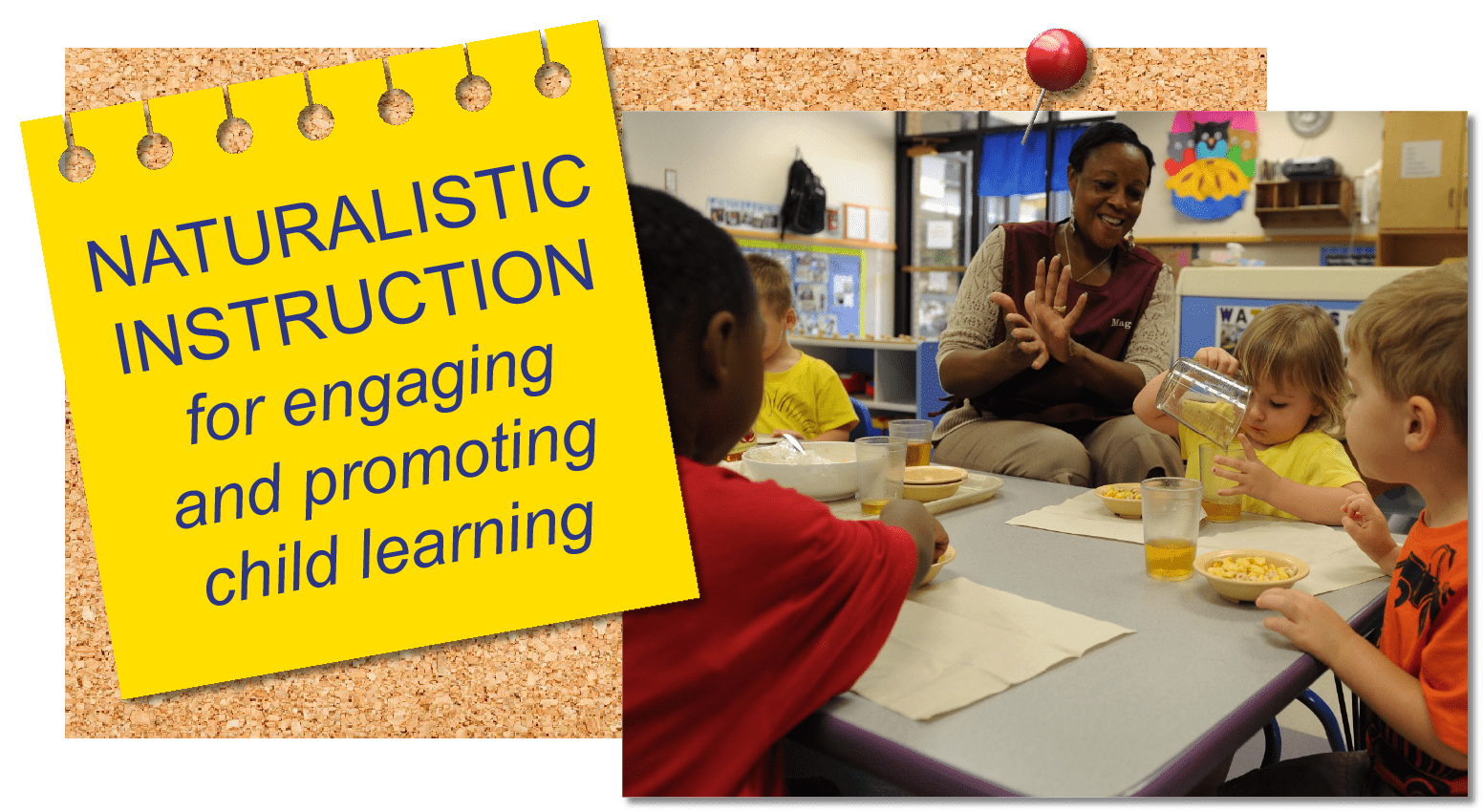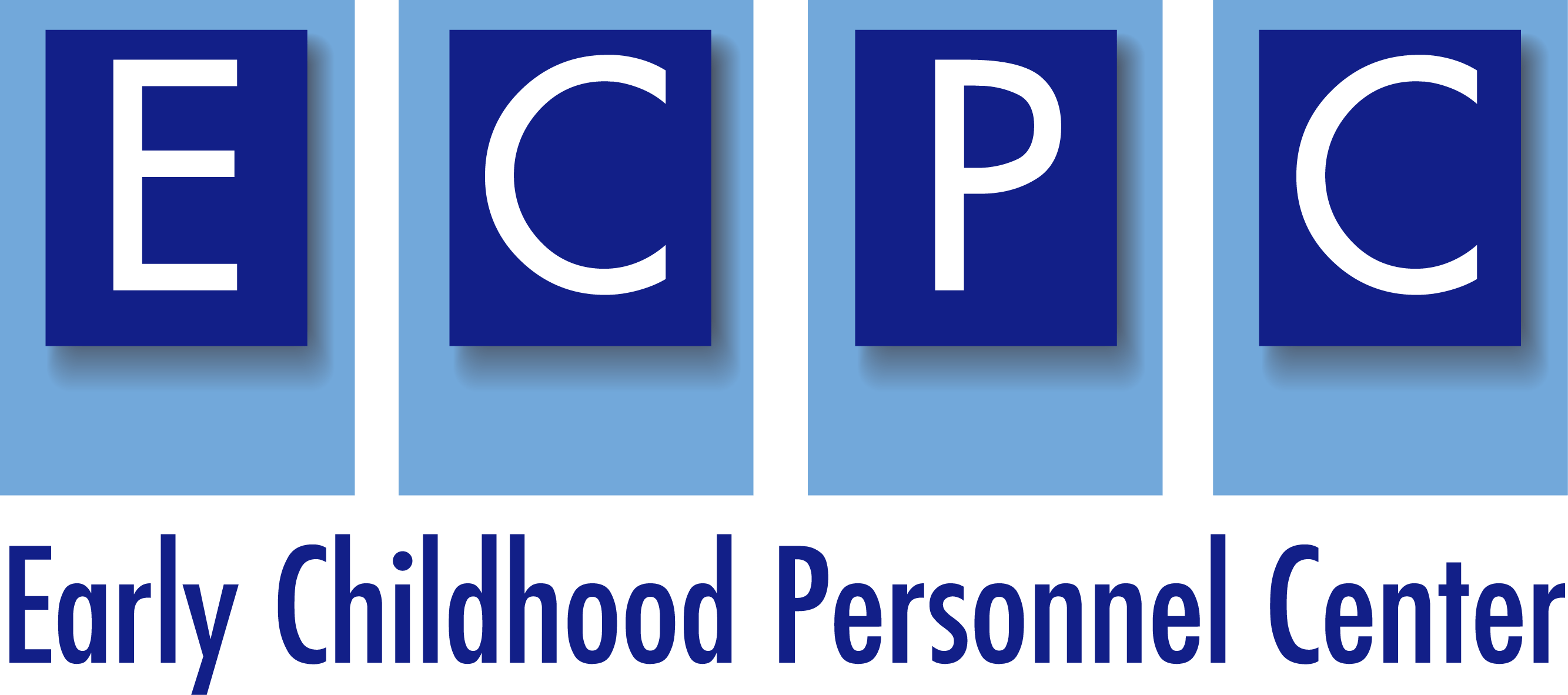
Definition
Naturalistic instructional practices are informal teaching methods used with infants, toddlers, and preschoolers to:
• Promote child engagement with people and/or materials
• Encourage child-initiated behavior
• Support child learning
Types of naturalistic instructional practices:
• Responsive teaching
• Responsive parenting
• Incidental teaching
• Relationship-based teaching
• Activity-based teaching
Need2Know
Research on the effectiveness of naturalistic instruction has grown exponentially in the past 10 years. Prior to 2000, there were only half a dozen reviews of research evidence for naturalistic instruction. In the past 10 years years, more than 20 research reviews indicate that naturalistic instruction is a highly effective practice for promoting child learning.

Child Engagement
- Children stay involved and participate in everyday activities for longer periods of time
- Children initiate interactions with materials and people more often
- Children do things in new and different ways
Characteristics
Naturalistic instructional practices share the following characteristics:
- Children learn as part of their engagement in everyday activities that match their interests and abilities.
- Use naturalistic instructional strategies to respond to child-initiated interactions or attempts to interact with objects or people.
- Be sensitive to children’s behavior and follow their lead. Pay attention to what the child does, wait, and notice when and how the child tries to interact in the activity. Shift your attention to match the child’s focus of attention.
- Respond promptly and positively to child’s behavior in ways that keep the child engaged in interactions with people and materials. This might be done by commenting on the child’s behavior, joining in and taking turns with the child, imitating the child’s actions, offering praise, or showing enthusiasm.
- During child interactions, encourage the child to try doing something slightly new or in a different way. Help expand on what the child is doing by asking questions, making suggestions, or demonstrating how to do something differently.
- Provide the child lots of opportunities to practice newly learned behavior.
Child Outcomes
Naturalistic instruction has been effective for promoting young children’s acquisition of
- communication and language skills,
- interactive competence,
- social-emotional behavior,
- play skills, and
- many other important child behavior.
Take a Look
Sensitive Responsiveness
Three-year-old Daniel stops playing and bangs his empty sippy cup on the floor. “Are you thirsty, Dani?” his mother, Lalia, asks as she jumps up and hurries to refill the cup at the kitchen sink. Dani toddles after her and stands, both arms encircling his mom’s leg, gazing up at what she’s doing. Their early interventionist, Julie, watches the interaction quietly. As Lalia hands Dani the cup, Julie comments warmly, “I see Dani has a new way to tell you that he wants more water! Your quick response was a great way to let him know that you understood his request.” Then Julie asks, “Did you notice how intently Dani watched you? I wonder if he would like to help.” Soon Dani is perched on a chair in front of the sink, laughing and babbling as he and Lalia fill and empty cups and pots of all sizes again and again.
Responding to Child Behavior
Preschool teachers Tim and Mara are expecting several new students in their inclusive class this term. While Mara helps 4-year-olds store coats and choose first activities, Tim greets each arrival. “Good morning, Mr. Martin, and hello, Chris!” he says, bending down to speak to a new student. Chris, who has low vision, has visited and explored the room several times, but this is his first day as a student. Recalling that Chris enjoyed the music corner on his last visit, Tim suggests they head that way. Two girls are already there, dancing to their favorite hip-hop-ABC recording. Chris sits on the floor, resting a hand on the player and swaying from side to side. When Tim notices Chris’s fingers drifting across the controls, he suggests Chris try each one to discover its function. Soon Chris is happily playing his classmates’ song requests.
Learning in a Routine Activity
During good weather, Laura and her assistant take the center’s 1-year olds to visit nearby sites such as a nature trail, a community garden, and a park. Pushing a bright blue multi stroller, they talk to the little ones about everything they see—from traffic signals to ripening vegetables to the colors of bicycles in a shop window. Getting in and out of the the stroller, as well as experiencing the outings, are familiar routines for the children. One day Laura notices little Micah point at things and then look toward her. She makes the gesture into a rhyming game, and soon everyone joins the fun. “Micah sees something! What can it be? It’s a mailbox! Say it with me!” On cue, the children babble their own approximations of “Mailbox!”, and the game continues with a new “pointer.” “Jenna sees something….”
You'll want to try this:
The more you involve yourself in naturalistic instructional practices activities, the more you will understand and be able to use this instructional practice. Try any or all of these activities:
- Download the Naturalistic Instructional Practices Checklist to monitor any and all opportunities to observe or use this practice.
- Together with a colleague or fellow student, observe practitioner-child and parent-child interactions and compare which checklist practices were used by the adults. Note the different ways in which the adults use the checklist practices.
- Seek input from faculty or program practitioners known to be proficient in using naturalistic instruction. Obtain their input and advice about things you can do to better understand and use the practice.
- Seek out opportunities to interact with young children and ask an early childhood practitioner to observe your use of naturalistic instruction and provide you feedback and guidance.
- The more opportunities you have to observe naturalistic instruction in different settings with different children, the more proficient you will become in using the practice.
Additional Information
To learn more about naturalistic instruction, take a look at these online resources:
Naturalistic Instruction Practices, a video from the Puckett Institute
It’s a Breeze to Help Your Child Learn
Infants practice guide
Younger Toddlers practice guide
Older Toddlers practice guide
ECTA Center Naturalistic Instruction practice guides
Family guide: Child Learning Comes Naturally
Practitioner guide: Naturalistic Instruction Practice
Windows of Opportunity Tune In and Respond practice guide
Getting in Step with Responsive Teaching steps from the Center for Everyday Child Language Learning
Get In Step with Responsive Teaching CELLvideo from the Center for Early Literacy Learning
ECPC Practice Guides are produced by
the Early Childhood Personnel Center,
University of Connecticut Center for Excellence in Developmental Disabilities, www.ecpcta.org
The development of the ECPC Practice Guides is supported, in part, by the U.S. Department of Education, Office of Special Education Programs. The opinions expressed, however, are those of ECPC, and no endorsement by the Department or Office should be implied or inferred.





